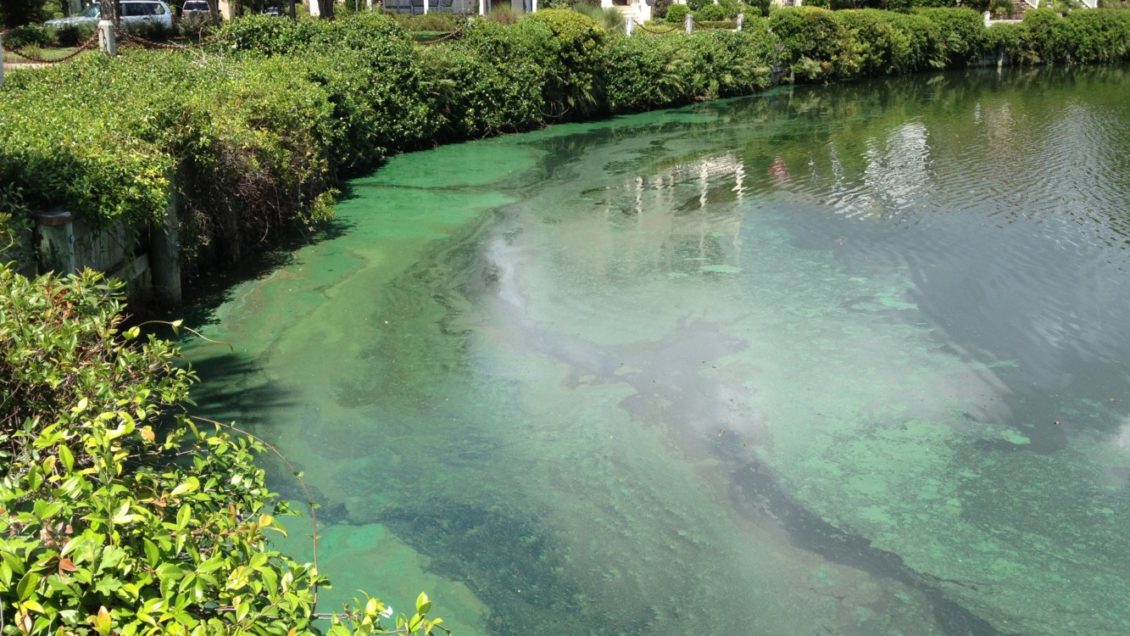CLEMSON — With recent reports attributing the death of some dogs in neighboring states to toxic blue-green algae in water bodies, Clemson Cooperative Extension is offering resources to South Carolinians pond owners to identify and prevent harmful algal blooms.

Cyanobacteria, or blue-green algae, shares both characteristics with both bacteria and planktonic algae — microscopic plants that live in every drop of pond water. Cyanobacteria can sometimes be considered a type of harmful algal bloom because, as the algae dies, toxins may be released into water bodies that can be harmful if ingested or contacted by pets, wildlife, livestock and humans.
“In the summer, you can have big rain events washing nutrients into ponds and that can stimulate an algae bloom,” water resources Extension agent Guinn Wallover said. “So it’s important to have a management plan in place that considers both nutrient prevention and algae control to help manage blooms.”
For owners, users and managers of private water bodies, Wallover pointed to a number of resources offered by Extension and other state and federal agencies for information on cyanobacteria, how to determine if it is present and, if so, what the best management strategies might be.
A series of fact sheets, available through the Clemson Cooperative Extension Home & Garden Information Center, contain information on the development of an integrated aquatic plant management plan and algae control. A fact sheet titled, “Cyanobacteria: Understanding Blue-Green Algae’s Impact On Our Shared Waterways,” includes extensive information on the topic of blue-green algae.
“This fact sheet provides information about the algae, why it occurs, what to do and prevention,” said Extension Natural Resources Program team leader Derrick Phinney. “This provides good background information on cyanobacteria.”
There are many types of algae and not all of them release harmful toxins. Clemson’s Plant Diagnostic Clinic can help with algae identification. The service looks for presence of certain algae (like blue-green), but it does not analyze for any algae-related toxins. A private lab may also be able to assist. The plant identification test, through Clemson, is $20 and can be submitted through any Extension office.
For management recommendations and strategies, Extension advises pond owners and managers to work with a pond management company. Companies that have completed Extension’s Certified Master Pond Manager course are listed here: https://www.clemson.edu/extension/water/hybrid-training/mpm/certified.html.
In water, cyanobacteria are naturally present in small numbers in slow-moving fresh or brackish water bodies, but when waterways become enriched with nutrients, naturally or due to human-related activities such as fertilizer application, the increased concentration of nitrates and phosphates can lead to rapid and explosive growth of cyanobacteria. This rapid growth is called a bloom.
Cyanobacteria blooms will typically occur on the surface of a water body and vary in color, often looking bright green to blue-green.
“Especially with really big blooms, blue-green algae can look like paint on the surface of the water — it will be a really brilliant blue-green color,” Wallover said. “But at the same time, I’ve been to some ponds where there’s definitely an algal bloom, but maybe if you’re not used to looking for what it looks like, it may be harder to discern. But a very thick bloom will be a really brilliant blue, green color and look like paint on the surface of the pond as scum.”
Cyanobacteria blooms have been labeled “harmful algal blooms” because they can release toxins into waterways as cyanobacteria cells die and breakdown. Of the 2,000 species of cyanobacteria that have been identified, more than 40 of these have the potential to release toxins, called cyanotoxins, into the environment
These cyanotoxins can impact human and animal nervous systems and livers, irritate skin, cause gastrointestinal issues and contribute to the development of tumors, and human and animal exposure to cyanotoxins can occur through accidental ingestion, direct contact or inhalation.
It is important to avoid exposure to harmful algal blooms. If you have been exposed to water where a bloom has occurred, shower or bathe as soon as possible and contact your health care professional. Symptoms of initial exposure can appear flu- or allergy-like.
Avoid contact with water and do not swim, boat or fish in the area. Use caution when walking along shorelines. Keep an eye on all pets and livestock and prevent them from drinking or accessing the water.
Those who believe they have been in contact with or ingested water containing cyanobacteria should seek professional medical attention as soon as possible.
Those concerned with blue-green algal blooms in public water bodies should contact DHEC for further information. DHEC also has further information about harmful algal blooms on its website. Questions about harmful algal blooms can be directed to Emily Bores at 803-898-4837 or boreseb@dhec.sc.gov.
The S.C. Department of Natural Resources also offers a list of pond management companies as a resource at http://www.dnr.sc.gov/wildlife/publications/pdf/LakeMgtConsultants.pdf.
Other pertinent links include:
- The Center for Disease Conrol’s webpage on Harmful Algal Bloom (HAB)-Associated Illness;
- A fact sheet from the S.C. Task Group on Harmful Algae;
- The United States Environmental Protection Agency’s webpage for information on cyanobacteria and cyanotoxins.
Get in touch and we will connect you with the author or another expert.
Or email us at news@clemson.edu

